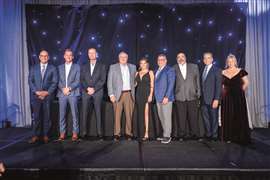Mile-high success!
25 November 2024
This year’s Scaffold & Access Industry Association (SAIA) Annual Convention & Exposition was a beehive of activity with a wealth of opportunities available for attendees.
Held Sept. 30 – Oct. 4 in Denver, more than 621 registered professionals descended upon the Mile High City to hear the latest industry expert insights, visit the sold-out exhibition hall, receive training, and celebrate the industry’s best during the President’s Gala and Awards Dinner.
During the event, the SAIA also named its new Executive Committee for the 2024-2026 period, including its new president, Mike Bredl.
Bredl, who also serves as the national sales and business development director at Universal Manufacturing Corp., where he has been for more than 35 years, has been an active member of the Scaffold & Access Industry Association since 1987. He has organized and led regional scaffold safety conferences, authored articles for magazines, and recently served as a member of the SAIA Board of Directors.
“It is truly an honor to serve in this capacity,” Bredl said. “As president, I am personally dedicated to engaging and welcoming new members into the SAIA community, updating our training programs to ensure they meet current needs and strengthening our relationships across the industry.”
 The newly appointed SAIA Executive Committee. (Photo: SAIA)
The newly appointed SAIA Executive Committee. (Photo: SAIA)
Joining Bredl are President-Elect Matt Morgan, Vice President Tom Brewer, Secretary Stefanie Bayard, Treasurer Frank Frietsch, Member at Large Michael Paladino, Board Appointee Roger Jetton, Board Appointee Chris Moody and Immediate Past President Tracy Dutting-Kane.
During his next two years as President, Bredl will oversee implementing the SAIA’s new three-year strategic plan that was approved and announced during the Annual in Denver. (To read more about the plan, click here.)
There are four key initiatives the Association will focus on in the coming years:
o Brand awareness and marketing
o Technology improvements (website and mobile app)
o Member development
o Workforce development and training
“We are wholeheartedly committed to developing and promoting best practices that address the evolving challenges our industry faces, seamlessly integrating these practices into our educational initiatives and training programs, with collaborative efforts through regulatory bodies,” Bredl said. “I encourage members to review our strategic plan and share your ideas, as we work together to ensure that we continue to be a beacon of excellence in our industry.”
Education and presentations
Looking at the current construction landscape and what could potentially play out in 2025, the Associated General Contractors of America’s Chief Economist, Ken Simonson, provided his take of the market, including opportunities – and challenges – to ahead.
 Attendees at the SAIA’s 2025 Annual Convention & Exposition. (Photo: SAIA)
Attendees at the SAIA’s 2025 Annual Convention & Exposition. (Photo: SAIA)
While construction is partially thriving, Simonson noted, parts of it are “already diving.”
“I think next year is going to be positive,” Simonson told attendees, “but I must say, it’s off to a rough start with twin blows from the massive damage in the Southeast [from Hurricane Helene] and the [port] strike affecting shipments of steel and scaffolding.
“I do think many of you are going to have a rough October – to a minimum – but hopefully there are smoother times after that.”
Simson highlighted that despite some major challenges the industry faces, such as the labor shortage, materials pricing, supply chain disruptions and a potential decline in multifamily construction, the construction industry as a whole is still adding jobs and growing.
“We’re seeing a lot of multi-family projects finish up and the financing isn’t there to get new projects, but single-family is beginning to recover, and residential construction is holding on and growing a little faster,” he said.
Multi-family construction has been running at near record levels for two years, Simonson said, and that’s due to taper off, while single-family construction is expected to rise between 5 to 10 percent. Non-residential, he noted, is “reasonably balanced between private and public, with public certainly doing better now than when you look at 2020.”
Both private and public, Simonson said, saw an 18% increase this year, while warehousing and retail dropped -20%.
Demand and need for data centers has seen that sector surge in the last few years, with construction within that sector up 57% year-over-year.
“I don’t think that can be repeated,” Simonson cautioned, “but I do expect strong double-digit growth.”
Despite the swings within certain sectors, Simonson believes the industry will fair well next year.
“The economy will still be growing next year, and with it, more demand for construction will happen overall,” he said, but with divergence, noting the expected declines in multi-family, warehousing and office construction but upticks in single-family and non-residential.
Concerns regarding labor, the supply chain and shifting markets are real, but on the flip side, the industry keeps adding jobs, lower mortgage rates could boost single-family builds, and continued investments in manufacturing and infrastructure projects are promising.
Making business easy for customers
In today’s fast-paced digital age, customer expectations have evolved significantly. Businesses must adapt to these changing demands to remain competitive. Business coach and consultant David Arvin, CSP highlighted the importance of prioritizing speed, simplicity, and exceptional customer experiences during his presentation “Ridiculously Easy to Do Business With.”
“I work with many CEOs and organizations, and the one question I ask every time is, ‘What’s your secret sauce?’,” he said to the audience. “And their answer is always some version of quality, or their commitment to caring and trust, and ‘the people.’ Some even say, ‘We do what we say we’re going to do.’”
But, Arvin cautioned, simply doing what you say you’re going to do is not enough.
In today’s day and age, “everybody’s good, or at least good enough,” he told attendees. “And sometimes, ‘good enough’ at a better price point is a better choice for some because if you weren’t ‘good enough,’ you’d be outed very quickly on Yelp or Trip Advisor or Glass Door.
“We are at a very unique time where quality is pervasive,” Arvin said. “Quality is important, don’t get me wrong, but nowadays, it is assumed.
“At the beginning of the day, it’s about quality, quality is the entry fee. But at the end of the day, it’s about competitive advantage and legitimately being a differentiator.”
In order to differentiate your business and not only attract, but retain, customers and clients, Arvin pointed to four key areas where businesses should focus: Having a customer-centric approach, a competitive differentiation, the ability to adapt and evolve with expectations, and effective communication.
Arvin said businesses must focus on providing seamless and efficient customer journeys. This includes quick response times, easy-to-use platforms and proactive problem-solving.
One key strategy involves omni-channel communication. By offering multiple channels for customer interaction, businesses can cater to diverse preferences and ensure timely support. Additionally, leveraging technology can streamline processes, automate tasks and enhance overall efficiency.
One last crucial factor, Arvin noted, is building strong relationships with customers. By actively listening to feedback, addressing concerns promptly and exceeding expectations, businesses can foster loyalty and positive word-of-mouth.
Additional insights
Attendees also heard how effective networking, and having a solidly built network of contacts that you can leverage on is vital for success from Diane Darling. Brian Andrews hosted a session that showcased how innovative scaffolding methods for accessing areas on a building or structure can be utilized. Matt DiBara explored strategies such as adopting a candidate-centric approach in employer branding, effectively using skills assessments and forming strategic partnerships that companies can employ to attract, develop and retain the talent needed to succeed in his session, “Elevating scaffolding: Strategic hiring for construction excellence, plus many more.
To see the presentations, check out the SAIA’s YouTube channel for more.
MAGAZINE
NEWSLETTER
CONNECT WITH THE TEAM






